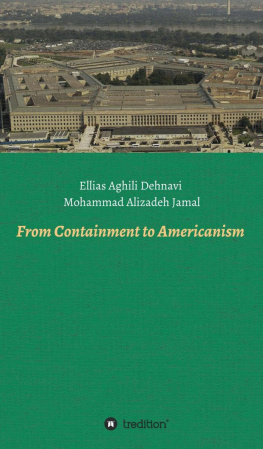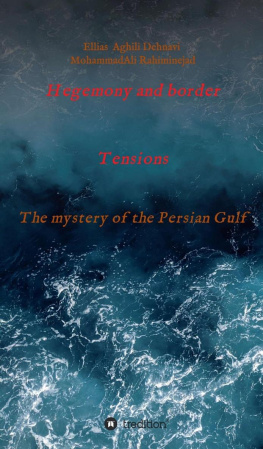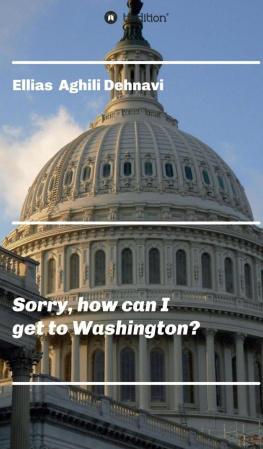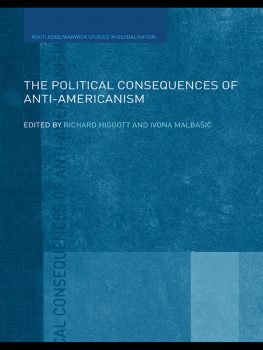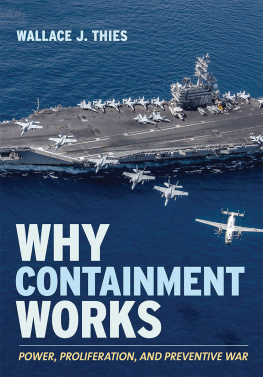Copyright 2020 Ellias Aghili Dehnavi, Mohammad Alizadeh Jamal
Publisher: tredition GmbH, Halenreie 40-44, 22359 Hamburg, Germany
ISBN |
Paperback: | 978-3-347-07320-3 |
Hardcover: | 978-3-347-07321-0 |
eBook: | 978-3-347-07322-7 |
Printed on demand in many countries
All rights reserved. No part of this publication may be reproduced, distributed, or transmitted in any form or by any means, including photocopying, recording, or other electronic or mechanical methods, without the prior written permission of the publisher, except in the case of brief quotations embodied in critical reviews and certain other noncommercial uses permitted by copyright law. For permission requests, write to the publisher.
From Containment to Americanism
To all of my lovely friends in Maryland and Virginia
Pamela Sinicropeher family and Sara Oakleaf
Preface
The present book examines the national security strategies of the presidents of the United States of America after World War II. The main question that has been asked in this regard is what approaches have these national security strategies had after the World War II? The present project is an analytical descriptive study done through interviews and library sources . Research shows that each of the American presidents had a national strategy in the aftermath of World War II, and in the post-World War II period, the US National Security Strategy has always had a global approach. An assessment of each of these strategies shows that although they have been developed and implemented in response to short-term concerns, they have also constituted some of the fundamental aspects of US foreign policy and macro-strategy; so that the next statesmen have followed its broad political goals and instructions. In other words, each of these strategies is based on previous strategies, which has led to political continuity and the benefit of the United States. In addition, it should be added that during the Trump administration, the national security strategy, due to its incompatibility with its allies and its strong priority over purely American interests, made this period noticeably different from previous periods.
Keywords: National Security Strategy, America, World War II, Cold War, Foreign Policy
1. Introduction
The United States, like any other country in its political history, has had different directions in diplomacy and foreign policy. The US National Security Strategy, which is based on the doctrines proposed by the government's intellectual and instrumental elites at the domestic and international levels, has always been and will continue to guarantee the national interests and security of this country. American citizens have witnessed various national security strategies over the past two and a half centuries. (Motahari Nia, 2005: 28-27).
World War II marked a turning point in American history and the beginning of a fundamental shift in US foreign policy toward globalization. Although World War I did not completely overshadow the doctrine of the American continents, but the new war led the irreversible diplomatic behavior of the United States to withdraw from the closed sphere of the Monroe Doctrine. The new doctrine after World War II, which with the name of President Harry of Truman, became known as the Truman National Security Strategy, no longer has the ability to administrate any limits on the implementation of the expansionist menus of US foreign policy. The study seeks to examine and explain US national security strategies in the years following the end of World War II.
2. Harry S. Truman National Security Strategy (April 12, 1945 - January 20, 1953)
Harry S. Truman was the 33rd President of the United States and a member of the Democratic Party. Truman, who began working as Franklin Roosevelt's deputy chief executive in 1944, took over the presidency after his sudden death. In 1948, he defeated the Republican candidate, Thomas Dieu, to become President of the United States for the second time.
The new national security strategy was based on the confrontation between the two opposing ideologies of imperialism and communism, and relied on the enormous potential of the United States during the war. In fact, World War II served as a powerful catalyst for the potential abilites of the United States to become de facto ability, so that from now on we will have to use new words to describe the United States: the superpower!
In fact, internal (internal) integration was the new and external (international) competitiveness that changed the US behavioral, strategic, and diplomatic patterns in global interactions. Upon careful study, we find that these causes and factors are all rooted in World War II, its evolution, and end.
From the beginning of the war, the United States has made military and security goals as its priorities. Thus, the United States began its power in the Pacific Ocean in 1941 and gradually expanded to the Atlantic Ocean. Then it was the turn for the Mediterranean.
He first deployed some troops in North Africa in 1942 and then went to Southern Europe in 1943. Finally, when the defeat of Germany was certain, and following
the opening of the Second Front in 1944, the United States succeeded in mobilizing 17 million troops and sending 10 million troops to the battlefields (p. Braillard Am, 1992: 39-33).
In addition, the abundance of "advanced" American equipment, even for the Soviet Union, was usefull in winning the war. Finally, the success of the Mantan project in fissioning the atomic nucleus (uranium and plutonium) and testing the first atomic bomb on July 16 at the Los Alamos Research Center in New Mexico made the United States extremely capable. (Kissinger, 1279) The criminal act of atomic bombing of the cities of Hiroshima (August 6) and Nagasaki (August 9) leaves no doubt about the military use of this destructive weapon and its use for political and security purposes.
Following the entry of the United States into the war, a law was enacted on December 20, 1941, requiring all males between the ages of 20 and 24 to serve under the flag. One year later, on November 18, 1942, the age of military service was reduced to 18 years, according to an amendment to the Draft Act.
With the entry of the United States into the war, the government gradually took on the role of political leader of the Allies. Relying on economic and military capabilities, it enabled the United States to impose its political views on European friends from the very beginning of the war by concluding the Atlantic Charter. Even with regard to the leadership of the war, Washington managed to appoint its own candidate, General Eisenhower, under the command of Allied forces (other than the Soviet Union), contrary to the wishes of London.
In addition, United state played a leading role in all political consultations and multilateral conferences, and in terms of a disagreement, Washington's vote would take precedence over others. It also had a global approach from the beginning of the US foreign policy war. January 1942 is a good implication to the fusion of traditional continental politics and modern world politics; On that date, the United States was able to force 21 countries on the continent to sever ties with the central governments, on the one hand, and 26 countries on the other, to sign the United Nations Declaration.



